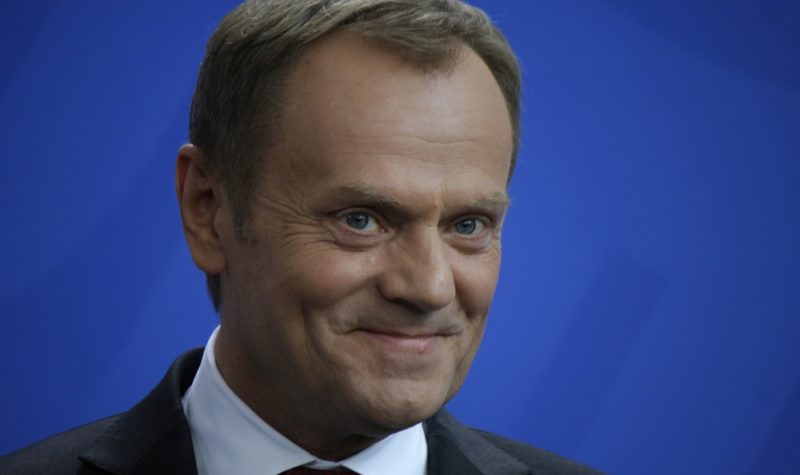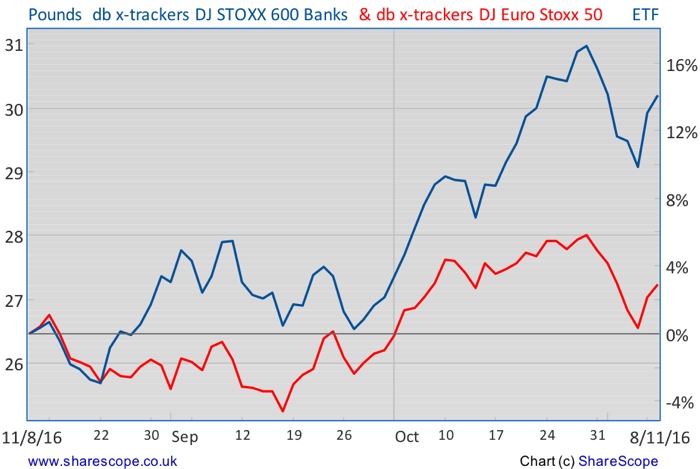Why Trump could be a huge relief for the Eurozone

Far from heralding disaster for the Eurozone, Donald Trump may soon help to replace the melancholic frown on European faces with a happy smile of hope. Here’s why…
While the world is still reeling from the Trump win over Clinton last Tuesday, there is a huge amount of information to be digested, analysed and filtered in order to understand how financial markets will respond over time. Above all, Trump represents a challenge to the status quo – something financial markets don’t take lightly and usually react to with volatility.
From today’s perspective, the overall impact on the markets has not been as significant as many would think. But last week saw a massive seesaw that moved the Dow 1,000 points, the FTSE 480 points, the EUR/USD 400 points, and gold $70. While the market tries to pinpoint the exact implications of Trump’s victory to the global economy, investors are granted a roller-coaster ticket for a financial markets ride. Any major bets placed in broad indexes, and in particular commodities like gold and oil, will likely suffer setbacks while the world tries to adjust to a new unknown equilibrium.
But while that happens there are some sectors of the economy that are already benefiting from Trump’s campaign promises. A case in point is infrastructure, which is expected to benefit from a refocus towards fiscal policy and government spending. It’s also the case with the pharmaceuticals sector, as Trump seems much more indulgent in relation to the pricing schemes of the industry. On that front, that’s really good news for depressed Valeant Pharmaceuticals (NYSE:VRX), which will take a less tortuous debt relief path.
But allow me to reserve the details of a thorough analysis on the implications of the US election result for the next issue of Master Investor Magazine. Today, I want to focus on a very specific angle that may soon help to replace the melancholic frown on European faces with a happy smile of hope. It regards monetary policy.
While Brexit and the U.S. election may certainly weigh negatively for the status quo of European integration, they may also help the Eurozone and its banking sector pull themselves together again. The European economy has been a victim of its banking sector for the past several years, and the banking sector has been a victim of the ECB’s policy steroids. With governments, companies, households and banks all deleveraging at the same time, the conventional measures of monetary policy were insufficient to boost the European economy. Cheaper loans did nothing to seduce companies to invest in a battered economy with plenty of capacity.
But although the rate cuts haven’t done much for the economy, they had a major impact on the banks. The lack of symmetry in interest-rate setting squeezed banks’ profit margins. European banks have always relied heavily on net interest income as a source of profit: they make money from the difference between the rate at which they lend and the rate at which they borrow.
When the ECB cut its key rates to zero, banks cut the interest charged on their lending but were reluctant to cut interest on their borrowing (deposits), because when key rates approach the zero level that would mean setting a negative rate, which corresponds to a charge on clients’ deposits. Because clients can easily withdraw money from their accounts, banks have avoided passing on the negative rates in full to their clients, and thus have seen their profit margins squeezed.
All this has been happening at a time when banks desperately need to improve their financial position, which explains why the STOXX Europe 600 Banks index has been battered to the ground no fewer than three times during the last seven years. Although banking stocks recovered quickly from the 60% decline that occurred during 2008-2009 (thanks to the ECB’s timely liquidity injection), banks retreated to similar values in 2012 and earlier this year (thanks to excess liquidity injection). The prospects of negative rates are the single most dangerous threat to European banks at this point.
The prospects of negative rates are the single most dangerous threat to European banks at this point.
Unfortunately for European banks, Ben Bernanke managed to find a way of dealing with negative rates which consists of purchasing assets on a large scale – the so-called quantitative easing. Such policy helps to flatten the yield curve and, as a side effect, reduce banks’ profit margins.
Mario Draghi imported the tool and started a huge asset purchasing programme involving the purchase of €60 billion per month in public and private debt, starting in March 2015 and ending in March 2016. But then the ECB decided to increase the pace of the asset purchases to €80 billion per month and to extend it until March 2017. Currently the ECB holds EUR 1.5 trillion in securities, which is equivalent to roughly 14% of the Eurozone’s nominal GDP.
This programme required the ECB to cut its deposit rate to -0.40% in order to be able to find enough securities in the market to fulfil its requirements. The outcome of this has been a massive decline in bond yields across the whole maturity spectrum and a bond bubble that has even turned some longer-term yields negative. Earlier in the year, a 10-year German government bond was yielding less than zero.
Being unable to charge clients’ deposits while being charged 0.40% on money deposited at the central bank and facing a flattened yield curve, banks could only end up being severely wounded. With the Union as a whole gripped by fiscal austerity and low inflation, and central banks around the world being too loose with interest rates, the prospects for further easing have been rising again – and with them the prospects for another round of pain for bank stocks.
Enter Donald Trump, who unexpectedly secured his election as the 45th US President. At first sight, the protectionism and disruption that come with him should wound the EU. After all, that’s the second warning this year that the people are tired of career politicians who are unable to put the global economy on a path towards prosperity; a warning that people are tired of seeing their living standards eroded while billionaires are protected by central banks and corporations escape the tax system. But, at second sight, it seems to me that Trump just puts a big smile on Draghi’s face while helping the case for the European common market.
Let’s start with the second point: the case for the common market. If Trump leads the world into an increasingly protectionist state, as promised, then why would anyone inside the European common market opt to exit and face a protectionist world alone? That’s something to think about.
If Trump leads the world into an increasingly protectionist state, as promised, then why would anyone inside the European common market opt to exit and face a protectionist world alone?
Let’s now revert to the first point, the big smile in Draghi’s face. Trump signals a break with the current state of monetary policy. He has criticised the FED and Janet Yellen regarding interest rates and ultra-loose policies. His stance is much more hawkish than Clinton’s, which means that, all else being equal, interest rates will rise faster and further. Trump may be unable to fire Yellen from the central bank but he will be able to appoint two new policymakers to the FED board next year. As time goes by, the FED will be filled with ever more hawkish policy makers.
What does that mean for the ECB? It means divergence in policy, which is something the ECB has not been able to create alone, but is something that it desperately needs. If yields start rising faster in the U.S., that means a rising dollar will make for a declining euro, which will help the inflation rate rise in the Eurozone. The ECB will be less likely to do something at its December meeting and less likely to postpone the end of its asset purchase programme. Yields in Europe will start rising again and so will bank profits. Trump’s hawkishness represents a massive relief for European banks.
Back in August, I recommended a long position in the banking sector because, by then, it looked very attractive in terms of value. Some banks were trading at prices that made them more valuable if sold off piecemeal than as going concerns. After reducing bad debts and recapitalising their balance sheets, European banks are in better financial shape than before the crisis. The main risk comes from the central bank’s unconventional policies.
With Trump promising fiscal spending and less accommodative monetary policy, banks’ prospects look brighter again. Back in August, the db x-trackers DJ STOXX 600 Banks ETF (LON:XS7R) was trading at £26.47. It now trades at £31.19. The performance of the STOXX 600 Banks index has been far better than the performance of the Euro STOXX 50. I expect this trend to continue, as there is still a large mountain to climb.


Comments (0)